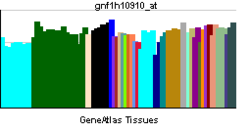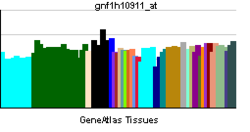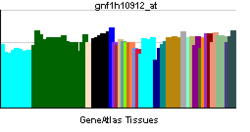- OR51V1
-
Olfactory receptor, family 51, subfamily V, member 1 Identifiers Symbols OR51V1; OR11-36; OR51A12 External IDs MGI: 3030454 HomoloGene: 66394 GeneCards: OR51V1 Gene Gene Ontology Molecular function • receptor activity
• olfactory receptor activityCellular component • plasma membrane
• integral to membraneBiological process • sensory perception of smell
• response to stimulusSources: Amigo / QuickGO RNA expression pattern 


More reference expression data Orthologs Species Human Mouse Entrez 283111 258808 Ensembl ENSG00000176742 ENSMUSG00000045132 UniProt Q9H2C8 n/a RefSeq (mRNA) NM_001004760 NM_146812 RefSeq (protein) NP_001004760 NP_667023 Location (UCSC) Chr 11:
5.22 – 5.22 MbChr 7:
103.49 – 103.49 MbPubMed search [1] [2] Olfactory receptor 51V1 is a protein that in humans is encoded by the OR51V1 gene.[1]
Olfactory receptors interact with odorant molecules in the nose, to initiate a neuronal response that triggers the perception of a smell. The olfactory receptor proteins are members of a large family of G-protein-coupled receptors (GPCR) arising from single coding-exon genes. Olfactory receptors share a 7-transmembrane domain structure with many neurotransmitter and hormone receptors and are responsible for the recognition and G protein-mediated transduction of odorant signals. The olfactory receptor gene family is the largest in the genome. The nomenclature assigned to the olfactory receptor genes and proteins for this organism is independent of other organisms.[1]
See also
References
Further reading
- Bulger M, Bender MA, van Doorninck JH, et al. (2001). "Comparative structural and functional analysis of the olfactory receptor genes flanking the human and mouse beta-globin gene clusters.". Proc. Natl. Acad. Sci. U.S.A. 97 (26): 14560–5. doi:10.1073/pnas.97.26.14560. PMC 18958. PMID 11121057. http://www.pubmedcentral.nih.gov/articlerender.fcgi?tool=pmcentrez&artid=18958.
- Malnic B, Godfrey PA, Buck LB (2004). "The human olfactory receptor gene family.". Proc. Natl. Acad. Sci. U.S.A. 101 (8): 2584–9. doi:10.1073/pnas.0307882100. PMC 356993. PMID 14983052. http://www.pubmedcentral.nih.gov/articlerender.fcgi?tool=pmcentrez&artid=356993.
{== External links ==
This article incorporates text from the United States National Library of Medicine, which is in the public domain.
Class II
(tetrapod specific receptors)Family 1Family 2A1 · A2 · A4 · A5 · A7 · A12 · A14 · A25 · A42 · AE1 · AG1 · AG2 · AJ1 · AK2 · AP1 · AT4 · B2 · B3 · B6 · B8 · B11 · C1 · C3 · D2 · D3 · F1 · F2 · G2 · G3 · G6 · H1 · H2 · J1 · J2 · J3 · K2 · L2 · L3 · L5 · L8 · L13 · M2 · M3 · M4 · M5 · M7 · S2 · T1 · T2 · T3 · T4 · T5 · T6 · T8 · T10 · T11 · T12 · T27 · T29 · T33 · T34 · T35 · V1 · V2 · W1 · W3 · W5 · Y1 · Z1
Family 3Family 4Family 5Family 6Family 7Family 8Family 9Family 10Family 11Family 12Family 13Categories:- Human proteins
- Transmembrane receptor stubs
- G protein coupled receptors
Wikimedia Foundation. 2010.
